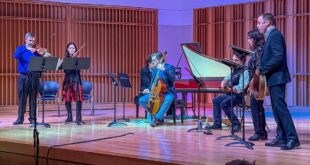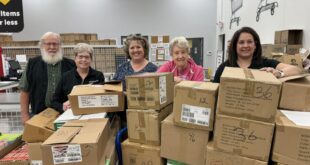CVS, at the Calhoun/Rudisell intersection, is like my grocery store. So I’ve known cashier Irene (Resendez) Rothgeb for a few years. She’s perpetually laughing, smiling, cracking a joke.
It’s hard to visualize a shy Irene. She and my dad, Willie Rozier went to Central High School almost a decade apart. He played all of the sports, had all of the friends. Irene could barely remember 2 friends. “I was real shy. I was just a loner. I went to school then came home. They used to call me a hermit.”
Central High School, and its previous iterations, served as the city’s first public high school. The school was formally named Central in 1922, when rival South Side High was built. It boasts powerful historical narratives for Anglo Americans, African Americans and Hispanics.
Irene graduated in 1970; Central was shuttered in ’71 (it’s now Anthis). She only attended the school for 2 years, but shy Irene emotionally connected with Central’s electric diversity; she still gets bored quick when things grow slow.
She attended Pierceton High School, then Central Catholic High, for one year each. Both schools grew boring. The city of Pierceton, even with a bigger Hispanic population, was small-town boring. Central reflected how she grew up.
“I didn’t associate that much with Hispanics in Fort Wayne. It’s not because I didn’t want to. I lived in a mostly black and white community. And you’re young so you play with whoever’s in your neighborhood.”
Central was clearly a friend. She brought the family poodle, painted Central blue and white, to football games. It closed though and “I was sad that it closed,” she remembered.
In 1970, George’s International hadn’t opened yet; you could only shop for clothes at the likes of Kmart. (Irene hated every Sunday school outfit picked by her mom and bought at Kmart.) There were places in Fort Wayne where Irene felt were off-limits, including nightclubs. “But we used to go to the Cat’s Meow, over by Stoner’s on Harrison.
“I didn’t feel right applying at certain places for office jobs. I just felt funny. [Like] maybe they wanted some tall, slender white person instead of a short, fat Mexican girl.”
The coming Mexican food explosion made it a little easier. Irene worked at one of the city’s first Mexican restaurants, the family-owned Taco Inn at Lake and Anthony. An aunt of hers worked at La Margarita’s and her cousin Johnny Rodriguez opened the famous Azteca Restaurant. He was featured in the Fort Wayne Newspapers when Azteca made its first million.
“I thought it was cool. If he could do it, then one of us could do it,” recalled Irene.
Soon everybody was eating authentic Mexican food, even the haters. Then Taco Bell came to town. It was never authentic, but it’s all good. Irene will eat Taco Bell, if she’s in a rush.
“I feel proud that more people are accepting. They love Mexican foods, they like going to the Spanish festivals. I feel more comfortable because they make you a part of it.”
Irene was made the manager of the Richmond (Indiana) Taco Inn. Out of her shell completely, she was featured in commercial spots; they called her the Taco Lady.
A long string of jobs ended with her current CVS position.
Her Spanish improved through her jobs; she learned the Spanish word for pregnancy while working for CANI (now Brightpoint). Irene never taught her kids Spanish, something she regrets. Her parents spoke Spanish most of the time.
I asked Irene where her dad Ernesto Resendez was born. “He came from the desert.” She didn’t immediately say Matamoros, Mexico. It’s telling that her first inclination was not to say the city’s name. She used a word that can be described as — through paraphrase – nothing but dirt. It’s probably how Ernesto remembers it.¬
Matamoros had one little grocery store; you had to bathe in the river. At one point, the Resendez family owned a large swath of land. Not anymore. Ernesto can never go back. “Now the cartels are there.”
Ernesto lived on the Mexican border and swam his way into this country. “He said he was a good swimmer but he was tired,” joked Irene. He used another man’s identity and surname, that of Ramirez. All of his eleven children were born in America; Irene’s the middle kid. He met his wife Eliza in the States. They always lived in small towns.
“My dad is a white-looking, authentic Mexican and my mom looks black. When they went to grocery stores, they would always made fun of my mom. So she would stay in the car.” Ernesto was often called wetback, slang for having to swim over illegally to get here.
He was a welder, one of his many jobs; Ernesto was at Fruehauf when it closed. Eliza was a housewife; she worked in factories like Pepsi and Wayne Candies when the kids got older.
Around when President Kennedy was assassinated, according to Irene, a FBI man came to the Ramirez home, looking for Mr. Resendez. The two men brokered a good-faith truce: become a United States citizen or be turned over to the authorities. The deal was approved by the then U.S. Attorney General, Robert Kennedy.
Ernesto Resendez will turn 90 on October 16. Eliza has passed on.
I asked not-so-shy Irene if she had anything left to say. “I’m real proud and happy and blessed to be a Mexican American.”
William Bryant Rozier is currently co-producing the 2nd Annual Central High All-Year reunion event with the African American Museum, to be held late April 2016. For a recap of 2015’s event, and updates on 2016, visit the event site (www.centralhighschoolfest.com) and Facebook page (facebook.com/CentralHighSchoolFest.com).
 El Mexicano News Providing local and national news
El Mexicano News Providing local and national news









